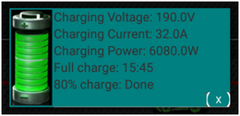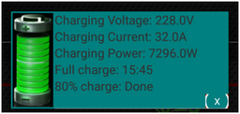Charging tests: 2017 Chevrolet Bolt EV
Charging test:
2017 Chevrolet Bolt EV
 The Elmec engineering team conducted Level 2 (240V) charging tests on a 2017 Chevrolet Bolt EV in order to measure maximum charging power for various input voltages.
The Elmec engineering team conducted Level 2 (240V) charging tests on a 2017 Chevrolet Bolt EV in order to measure maximum charging power for various input voltages.
PREMISES:
- The 2017 Chevrolet Bolt EV specifications mention that the vehicle’s on-board charger has a 7.7 kW power output.
- Thus this theoretically means that, at 240VAC, the maximum charging current is 32A.
QUESTIONS:
- What about when the voltage is different from 240VAC?
- Is power the only limiting factor, thus the current would be higher if the voltage was lower?
TEST:
An EVduty charging station has been programmed voluntarily (and temporarily) to “tell” the vehicle that it can provide 80A, the maximum current allowed by the SAE J1772 standard which governs communication between the charging station and the vehicle during charging. This way, the station will not limit charging current. This charging station will be powered sequentially by two very common types of power supply: 240VAC and 208VAC. A multimeter was placed directly at the charging station input to measure voltage and current. In order to validate the measurements picked up by the multimeter, voltage and current were also measured in the vehicle using an OBD2 reader (vehicle’s on-board diagnostic port) and the “MyGreenVolt” mobile application
-
Note 1:
During charging, there appears to be a significant voltage drop from the nominal voltage value. For example, at 208VAC, voltage drops to 196VAC, a loss of 6%. This is due to the electrical installation that contains a considerable length of #10AWG cable, since we usually use this power supply solely for function tests and not for testing charging at full power. Theoretically, voltage drop should be no more than 3-5%. -
Note 2:
There seems to be a difference between voltage measured by the multimeter and that measured by the vehicle. Several reasons can explain this difference: the instruments’ measurement accuracy, the 25′ #10AWG charging cable, the connection to the vehicle’s charging port, etc.
RESULTS:
208VAC power supply:
- Initial voltage: 206.4VAC
- Voltage measured at the charging station’s input during charging: 196.1VAC
- Current measured at the charging station’s input during charging: 32.3A
- Voltage measured at the vehicle during charging: 190.0VAC
- Current measured at the vehicle during charging : 32,0A

240VAC power supply:
- Initial Voltage: 240.6 VAC
- Voltage measured at the charging station’s input during charging: 231.5 VAC
- Current measured at the charging station’s input during charging: 32.3 A
- Voltage measured at the vehicle during charging: 228.0 VAC
- Current measured at the vehicle during charging: 32,0 A

CONCLUSIONS:
- Charging current is limited to 32A, regardless of voltage supply. Thus, the 7.7kW specification is the maximum power limit and there is also an internal current limit of 32A. We can therefore hypothesize that if voltage was greater than 240VAC, current would be reduced to meet the 7.7kW limit.
- If the voltage supply is lower than 240VAC, the charging current will still be limited to 32A. Since the power is equal to the product of voltage and current, the charging power will be reduced if voltage supply is lower. In this case, charging time will also be longer.
- It should also be reiterated that in this case, the charging station allowed the vehicle to reach a maximum current of 32A because it was programmed to offer 80A. An EVduty EVC30 charging station (unmodified) provides a maximum of 30A and the vehicle meets this limitation by decreasing its charging current to 30A. For a Chevrolet Bolt with a 60kWh battery, this difference of 2A represents about 30 minutes increase of charging time if the battery is completely depleted and about 15 minutes more if the battery is at 50%, a rather insignificant additional time.
COMPLEMENT:
- At the end of this test, we reprogrammed the EVduty EVC30 charging station to its 30A nominal output current value and took exactly the same measurements. The charging current was indeed 30A, measured both by the multimeter and by the vehicle. (We did not doubt this result, but as we had the entire measurement setup in place, this additional test was easy to do.)

Leave a comment